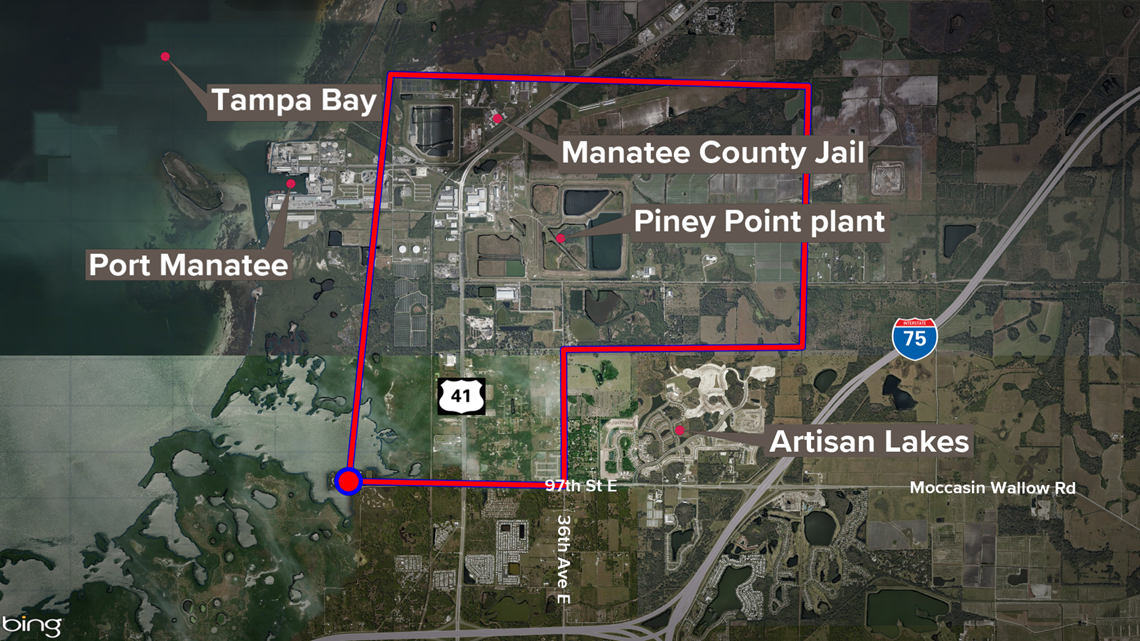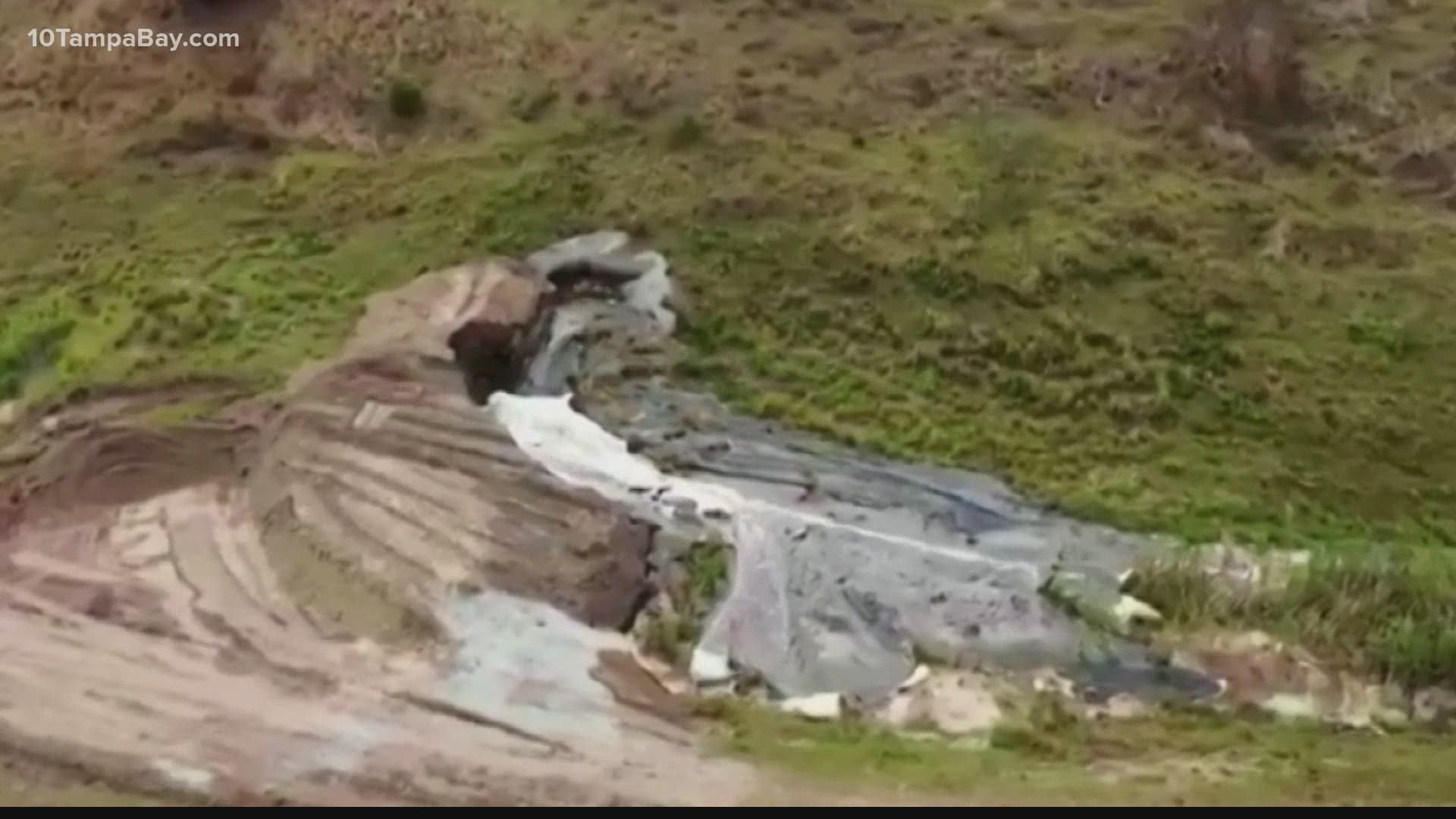BRADENTON, Fla. — There remains about 340 million gallons of wastewater that still could suddenly be released from the breached Piney Point reservoir.
If such a collapse were to happen -- and that remains the worst-case scenario -- one model suggests there would be a 20-foot "wall of water" flooding the surrounding area, said Dr. Scott Hopes, Manatee County's acting administrator.
Florida Gov. Ron DeSantis joined Hopes and other local, state and federal leaders on Easter morning to detail the information about the emergency situation, which continues to be critical until crews prove successful in draining the water-covered phosphogypsum stacks at the former Piney Point phosphate processing plant.
It's why there remains an evacuation order in the area, encompassing about 316 homes. There are no public supply wells within the evacuation zone, said DeSantis, though the state is moving bottled water to people in the area.


The wastewater being discharged from the site to Port Manatee -- and eventually out into Tampa Bay -- is not radioactive, DeSantis said. It's still not the sort of water anyone would want to have in contact with the environment.
The governor explained the water primarily is saltwater mixed with legacy process water and stormwater runoff. There is a high amount of nutrients in the water, such as phosphorous and nitrogen.
"To date, dissolved oxygen, salinity and pH all meet water quality standards," DeSantis said. "Additional water quality information, including additional parameters, will be available in the coming days."
The Florida Division of Emergency Management is moving 20 additional pumps to the site to increase the amount of wastewater drainage, DeSantis said. Crews are up to removing 35 million gallons per day with, again, 340 million gallons remaining on site. There will be several more days of draining before the emergency is considered lessened.
"We're hoping that we can just continue to get the water out in an efficient way and prevent a catastrophic event, but we have to prepare that this could be something where you see further degradation," DeSantis said.
The greatest danger right now is flooding, which is why people need to get out of the evacuation zone and stay away from the area, Florida Department of Environmental Protection Secretary Noah Valenstein said.
Inmates and staff in the nearby Manatee County Jail are currently safe, said Hopes, who explained the flood potential in that area would reach 1-5 feet. All personnel and the medical unit have been moved to the second floor, and the ground floor has been sandbagged, he added.
Valenstein said people can see the latest water quality information on the "Piney Point Regional Notification" page on ProtectingFloridaTogether.gov.
Jenna Stevens, the state director of Environment Florida, in a statement cast blame on the site's current owners, HRK Holdings, and said the current emergency has been preventable.
"The situation at Piney Point has been a slow-moving disaster that scientists and advocates have warned about for years," reads Stevens' statement, in part. "Floridians and particularly residents of the Tampa Bay region treasure our amazing ecosystem and the wildlife that inhabit it. Now, our region is preparing for devastation that was preventable, including the potential destruction of seagrass that’s recently been restored to historic levels."
DeSantis stressed his administration is "dedicated to full enforcement of any damages" to the region's natural resources.
The Borden Chemical Company first built the now-closed phosphate processing plant in 1966. It was later owned by Royster Phosphates, Inc., then purchased by the Mulberry Corporation in the 1990s.
It was abandoned in 2001 when Mulberry declared bankruptcy. Today, it is owned by HRK Holdings, and Florida’s Department of Environmental Protection has oversight.
Congressman Vern Buchanan's office said a 2019 study found the former plant might only be two years away from reaching capacity. Now, in 2021, the problem is confronting the community head-on.
“This is extremely serious,” Buchanan wrote in a statement Friday. “The state and the county need to work together and resolve this as quickly and safely as possible.”
Hopes during the Sunday news conference said once this emergency passes with the draining of the site, a more permanent solution would be to infill the stacks and put a sort of cap on top to prevent a future disaster.
- Water seen flowing from Piney Point reservoir Sunday morning
- Breach ongoing at Piney Point reservoir, leaders say, as crews try to prevent collapse
- Evacuations ordered over 'imminent' threat millions of gallons of wastewater could gush into Manatee County
- How long does COVID-19 vaccine immunity last?
- Why some Florida teachers aren't happy with DeSantis' proposal to give every teacher a $1K bonus
- What to do this Easter weekend across the Tampa Bay area
►Breaking news and weather alerts: Get the free 10 Tampa Bay app
►Stay In the Know! Sign up now for the Brightside Blend Newsletter

